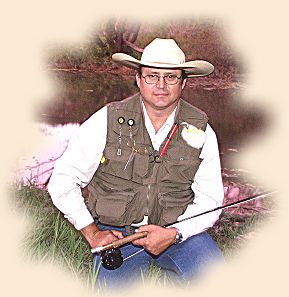February in Texas Hill Country means one thing to the
fly-fisher, White Bass! They typically begin their
spawn in middle to late February and continue to about
the middle of March, give or take a week or so. The
Whites, Sandies as known in the north, will move out
of the deeper waters of the lakes and reservoirs, up
into the river and creek channels to begin their spawn.
The reason for this is they need flowing oxygenated
water supplied to the eggs during incubation. During
the spawn the bass will eat ferociously and being
aggressive predators, minnow patterns work extremely well.
This year the winter has been very mild and temperatures
are already 10 degrees higher than normal on many days.
One thing about fishing weekends during the run, it gets
crowded and many of the smaller rivers such as San Gabriel
can quickly become over crowded and non-fishable for a
fly-fisher. The concentration of fish is great, but
within a small area or stretch of the river. For this
reason I try to get out on weekdays, besides what are
sick days for? Hope the boss does not read this. I also
prefer to go someplace that's a little harder to get to.
90% of the people you see during the run will never be
seen again until the next season and of those, most go
to places that are conveniently reached. San Gabriel
being easily within 5 to 15 minutes from the surrounding
towns including Austin, ample access and easily waded,
becomes very over crowded and most do not fly-fish nor
understand the space needed by those who do. Occasionally
tempers do flare.
So, where do I go? It's not a big secret. Colorado Bend
State Park is a great place to fish the White Bass Run.
It is out of the way, not so much by distance, 124 miles,
but how you get there. There is no direct straight path
from the Austin area and the last traveled road is dirt
for some miles and can be rough if maintenance has been
delayed for weather reasons.
The one-horse town of Bend and it's single General Store
is the last source for supplies, including ice before
hitting the dirt track and starting the last leg into
Colorado Bend Park. The park is located at the bottom
of the river canyon and has beautiful semi-primitive
campgrounds. Large Pecan and Oak trees are abundant,
providing ample shade during the hot summer months.
Plenty of hiking trails and at either end of the park
boundaries are clear cold spring fed creeks. Of the two,
Gorman Creek, has a beautiful set of falls and guided
tours are available. Also pre-arranged guided cave tours,
your choice, walking or crawling. When the fish are not
cooperating, there are plenty of other activities to keep
one's self entertained.
The morning we left out of Round Rock the skies were clear
and the temperature was a mild 65 and on the rise. Andy
had never been to Colorado Bend so this would be an
adventure for him. As it turns out, for the both of us!
We took hwy 29 West out of Georgetown and headed straight
to Llano. From there we took hwy 16 north to Cherokee and
made a turn back to the east on fm 502 to Bend. It's a
great ride through some beautiful Texas Hill Country.
Lots of very fishable waters are crossed or passed by
with a great view including San Gabriel South and North
forks, Colorado River that forms Inks Lake and Buchanan.
Llano River is paralleled for some distance before making
the turn to the north at Llano. Cherokee creek is a large
creek but with little access.
After we left bend and started on the dirt road, we were
just over halfway to the ranger station when the rear back
tire blew out. Normally this would be no big deal. However
when getting the jack ready for raising the truck, the lug
wrench was found to be missing! Not only did it remove
lugs but was needed to lower the spare and operate the
jack! So here we are out in the middle of nowhere and
with no way to change a flat. Fortunately it was a
weekend and with the run going on, we did not have to
wait long for a passing truck, which stopped and got
us out of a sticky situation by lending his lug wrench.
Also about 15 minutes later a ranger came by, stopped
and made sure we were OK. I would have hated to walk
the distance to the ranger station for help.
Once we arrived, we launched the boat and were on the
water in no time. Now we started the process of finding
the fish. The waters here offer both wading and boating.
During the white bass run all kinds of floating craft can
be seen. Some of the homemade ones are quite interesting.
Have not seen any bathtubs yet, but I would not be surprised.
The waters here along the park range 15 feet near the canyon
walls up to a comfortable 3-foot wading depth. During the
months of January and February it's possible to see wintering
Bald Eagles while fishing these waters. Other wildlife is
abundant also.
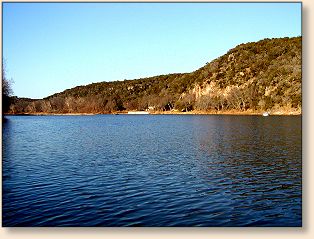
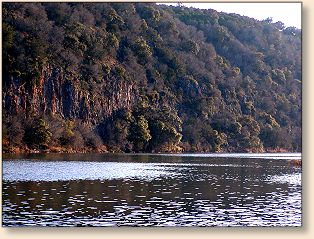
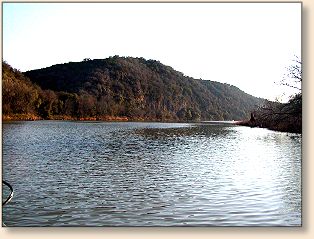
I started out with a bead-headed white woolly bugger and
it is necessary to have a sinking line or tip, as whites
are not top feeders unless the shad, their primary food
source, is running near the surface. I use multi-tip
lines with 14-foot interchangeable tips. The only tough
part about white bass is finding the depth they are holding.
We started in the deep section around 15 feet and after
several yards and multiple casts nothing was happening for
either of us. Andy was using a spin caster with a white
Mr. Twister Grub spinner. So we picked up and headed into
shallow waters farther up river into about 4 feet of water.
After about another hour's worth of drifting and casting,
we still had no results. It was beginning to look grim,
we only had about 3 hours of good fishing time left.
Finally I decided to split the difference. We went into
about 8 feet of water and close to the park bank where it
was a smooth sandy bottom. Again no strikes, but people
all around us were catching fish! What were we doing wrong?
At this point I just sat back and watched. I was not looking
for what type of fly was being used but much more interested
in the retrieval speed and stripping lengths. After a few
moments I realized my retrieval was too slow and I needed
to keep the streamer off the bottom.
Now maybe there was hope for this trip after all! I cast
back out towards the channel and did not give the sink line
enough time to reach bottom, began stripping in about 8 inches
a second and WHAM, took a hard hit on the fly, paused a
second and began stripping...WHAM, another hard hit but
no hookup. This went on and on for several casts. Andy
was getting the same results after I told him not to let
his spinner sink to the bottom before retrieval. After
he had several hard hits, I asked to see his grub before
he recast. Sure enough the last section of the tail had
the signs of hard bites as well as pieces missing. I told
Andy to down-size his grub or cut off the tail. I on the
other hand, traded the woolly for a Mylar minnow. This
was a smaller fly and the tail ended just at or slightly
past the hook bend.
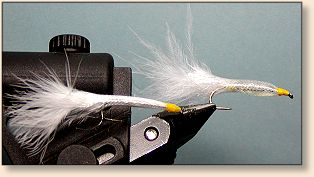
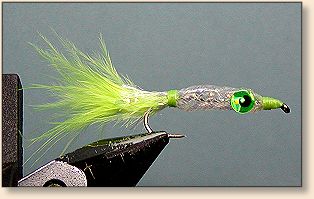
I cast back out and stripped in the line, nothing, hmmmm.
I made another cast and felt a slight bump, paused and...WHAM,
fish on! This was a definite hook up! This fish did not
want to come up! After a few minutes of tussling, I got
him up and it was a nice 12 inches.
In the mean time, Andy was having his share of fish also.
Once he shortened up the tail, he was getting almost all
the fish that hit. He was having a ball and some of his
were of notable size also. The largest of the day was
14 inches and there were a lot of small ones, but they
too were just as fun.
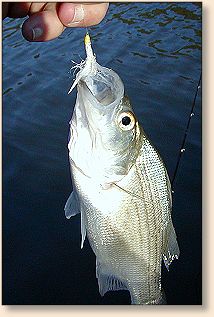
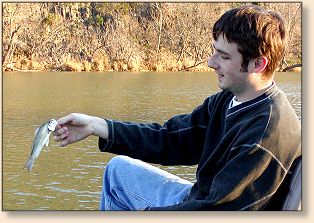
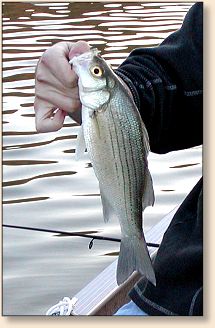
All in all it was a great day. In the 2 hours we had left,
the total fish between the two of us was 47 fish. Justin,
Freebirds on the BB, was there also with a couple of friends.
Between the three of them they landed around a hundred fish,
including 2-pound crappies! On the way out that night the
deer were coming out. They have no fear of humans in this
park as evidenced by this parting shot in near darkness.
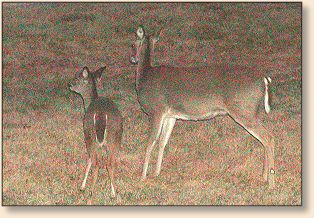
Andy is bringing his fly rod on the next trip and promises
to have everything needed to change a flat. We have 9 days
off from work coming up...wonder where we'll be?
Good fishing to all. ~ Hillfisher
|

